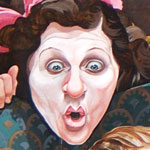
 (October 29, 1891 - May 29, 1951)
(October 29, 1891 - May 29, 1951)
Fanny Brice was a popular American comedienne, singer, and actress known best as the creator and start of the highly acclaimed radio comedy series The Baby Snooks Show. Born Fania Borach in New York City to the Hungarian-Jewish owners of a saloon on the lower East Side, Brice dropped out of school in 1908 to pursue show business. Her first public appearances came in burlesque before she was given her "big break" by Florenz Ziegfeld as a featured performer in his Follies of 1910. Brice was a Ziegfeld headliner for well over two decades.
The Follies of 1921 spurred Brice's successful recording career as her signature song, "My Man," became a popular hit. Under contract with both Victor and Columbia Records, Brice made well over a dozen records including many of her "dialect songs" such as "Second Hand Rose." "She always considered the song one of her most successful pieces." 1
In Hollywood, Brice made a few pictures, including My Man (1928) and Everybody Sing (1938) with Judy Garland. Brice is one of only three original Ziegfeld performers to portray themselves in the two films about the Follies, The Great Ziegfeld (1936) and Ziegfeld Follies (1946). Brice was given a star on the Hollywood Walk of Fame.
Despite her great success on the New York stage and her limited accomplishment on screen, Brice is probably best known to American audiences from her radio career. From the 1930s until her death in 1951, Brice performed her famous "Baby Snooks" character as part of The Ziegfeld Follies on the Air on CBS Radio in 1936, then on NBC's Good News in 1937, CBS's Maxwell House Time in 1944, and finally her own show on NBC in 1948 first called Toasties Time, but later known as The Baby Snooks Show. 2 Brice was dedicated to her creation and once explained "she's got a lot of high spirits and loves good clean fun, but she is never vicious or mean, and if she is, it's the fault of my script writers." 3
Brice was, first and foremost, an entertainer, but she did have a somewhat publicized personal life. Her first marriage was to a barber named Frank White. This union was during her teen years and was quickly dissolved. Her most famous marriage was to the professional gambler Julius "Nicky" Arnstein, whom Brice divorced after stints in both Sing Sing and Fort Leavenworth prisons. Her final marriage was to songwriter and stage producer Billy Rose, who featured Brice in his Crazy Quilt revue in 1931. Unfortunately, this bond was broken as well.
Six months after making her first and only appearance on television on CBS's Popsicle Parade of Stars, Brice died in Hollywood of a cerebral hemorrhage. At the age of fifty-nine, Brice was interred at the Westwood Village Memorial Park Cemetery in Los Angeles. Memorials on both television and radio were broadcast the week of her funeral.
Fanny Brice is probably best known to Americans in the second half of the twentieth century due to the success of Broadway musical-turned Hollywood film based on her life and career. Funny Girl, with music by Jule Styne, opened on Broadway in 1964 starring Barbara Streisand and received critical acclaim. Focusing mainly on her working relationship with Florenz Ziegfeld and her failed marriage with "Nick" Arnstein, the stage production was filmed for the screen in 1968 and earned Streisand an Academy Award. In 1975, the sequel Funny Lady focused on Brice's relationship with Billy Rose and featured Brice's own signature songs. Although many liberties were taken with both accounts of her life, Brice's spirit lives on in the portrayals of this great entertainer's life.
1. Grossman 123
2. Grossman 231-3
3. Grossman 231
Resources
"Fanny Brice." Wikipedia. http://en.wikipedia.org/wiki/Fanny_Brice 28 September 2007.
This online research database provides basic chronologies, anecdotes, and a useful place from which to begin research. However, at times, the "facts" are questionable.
"Fanny Brice." IMDb. http://www.imdb.com/name/nm0108511 28 September 2007.
This online database provides complete filmographies, mini-biographies, and trivia for all persons who have made motion pictures.
"Fanny Brice." IBDB. http://ibdb.com/person.asp?ID=66952 29 September 2007.
This online database provides complete stage credits, biographical facts, and awards for all persons who have appeared on Broadway.
Goldman, Herbert G. Fanny Brice: The Original Funny Girl. New York: Oxford UP, 1992.
Goldman's biography is brief in comparison with other celebrity life stories. Despite being rather concise, it is filled with useful facts about both the private and public life of Brice and features several helpful appendices.
Grossman, Barbara W. Funny Woman: The Life and Times of Fanny Brice. Bloomington: Indiana UP, 1991.
Grossman's biography is a little more in-depth than Goldman's study, offering more anecdotes and first hand accounts. However, Grossman does not offer any lists of films, recordings, or stage appearances as does Goldman.
Katkov, Norman. The Fabulous Fanny. New York: Alfred A. Knopf, 1953.
Katkov's biography is the lightest of the sources that I found. However, written just two years after Brice's death, this book offers the reader direct quotes from Brice's friends, family, and co-workers.